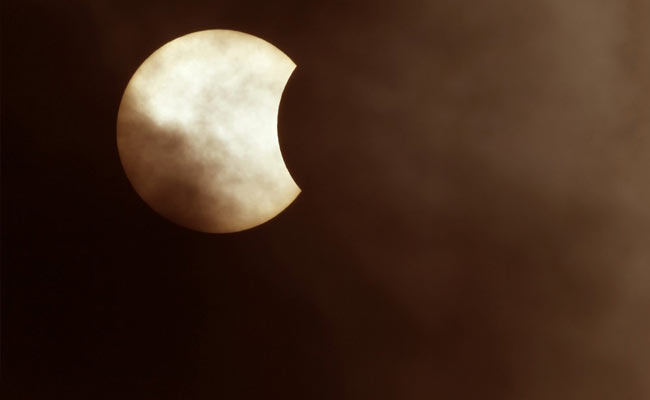The annular solar eclipse, popularly known as the "ring of fire" eclipse, was visible in India today, with social media flooded with pictures from the rare celestial event. This was the first solar eclipse of 2020. Skywatchers living within a narrow band covering parts of Rajasthan, Haryana, and Uttarakhand were able to see the "ring of fire" with much clarity.
The first solar eclipse of this year which coincided with the summer solstice, when the Northern Hemisphere has the longest day, was an annular eclipse. Apart from India, the eclipse was visible in Congo, Sudan, Ethiopia, Yemen, Saudi Arabia, Oman, Pakistan, and China.
The eclipse started around 10:20 am and ended around 2:20 pm. It is also known as Surya Grahan in India.
The eclipsed sun should not be viewed with the naked eye, even for a very short duration of time. It may cause permanent damage to the eyes leading to blindness even when the moon covers most portion of the sun.
"Annular solar eclipse is a particular case of the total solar eclipse. Like the total solar eclipse, the moon is aligned with the sun. However, on that day, the apparent size of the moon happens to be a wee smaller than the sun. Hence the moon covers the central part of the sun, and the rim of the sun appear like a "ring of fire" in the sky for a very brief moment" Samir Dhurde of The Inter-University Centre for Astronomy and Astrophysics said.
Here are the Highlights on the solar eclipse:
Karnataka: Temples in Hubli remain closed in the light of #SolarEclipse2020. pic.twitter.com/fv238yLPqP
- ANI (@ANI) June 21, 2020
 Solar Eclipse 2020: Surya Grahan In Pictures, Video, Significance And Timings
Solar Eclipse 2020: Surya Grahan In Pictures, Video, Significance And TimingsSolar Eclipse 2020: This year it is an annular eclipse also called the 'ring of fire'. The majestic event started at 9:15 am and will reach its peak at 12:10 pm in India. The annular eclipse is visible from parts of Asia, Africa, Europe and Australia."

#SolarEclipse2020 as seen in Kathmandu of Nepal.
- ANI (@ANI) June 21, 2020
As per Nepal's BP Koirala Memorial, Planetarium Observatory and Science Museum Development Board the solar eclipse will be visible from 10:52 am to 2:32 pm today. pic.twitter.com/4peHmaoVyB


Punjab: #SolarEclipse2020 as seen in the skies of Amritsar today. pic.twitter.com/usRHFtjlgP
- ANI (@ANI) June 21, 2020
Uttarakhand: #SolarEclipse2020 as seen in the skies of Dehradun.
- ANI (@ANI) June 21, 2020
The solar eclipse will be visible until 1:50 PM with maximum visibility of the eclipse at 12:05 PM. It will be visible from Asia, Africa, the Pacific, the Indian Ocean, parts of Europe and Australia. pic.twitter.com/iugvgwFEYR
WATCH | The first solar eclipse of 2020 is visible from most parts of India. NDTV reports from Delhi's Nehru Planetarium. #SolarEclipse2020 pic.twitter.com/RzOs5HoGH3
- NDTV (@ndtv) June 21, 2020
United Arab Emirates: #SolarEclipse2020 as seen in the skies of Dubai.
- ANI (@ANI) June 21, 2020
The solar eclipse will be visible until 11:12 AM. It will also be visible from Asia, Africa, the Pacific, the Indian Ocean, parts of Europe and Australia. pic.twitter.com/EAGWuVIdBO
Gujarat: #SolarEclipse2020 seen in the skies of Gandhinagar.
- ANI (@ANI) June 21, 2020
The solar eclipse will be visible until 1:32 PM with maximum visibility of the eclipse at 11:42 IST. It will be visible from Asia, Africa, the Pacific, the Indian Ocean, parts of Europe and Australia. pic.twitter.com/Lp0xs53JoF
Madhya Pradesh: Portals of temples in Bhopal remain closed in the light of #SolarEclipse2020 today.
- ANI (@ANI) June 21, 2020
The solar eclipse will start at 9:15 AM today and will be visible until 3:04 PM. pic.twitter.com/Rtch2qi2mM

#WATCH Jammu and Kashmir: Jammu witnesses #SolarEclipse2020
- ANI (@ANI) June 21, 2020
It will start at 9:15 AM and will be visible until 3:04 PM. The maximum eclipse will take place at 12:10 IST. It will be visible from Asia, Africa, the Pacific, the Indian Ocean, parts of Europe and Australia. pic.twitter.com/hewOopYiCY
Delhi: #SolarEclipse2020 as seen in the skies of the national capital today.
- ANI (@ANI) June 21, 2020
The solar eclipse will be visible until 3:04 PM. The maximum eclipse will take place at 12:10 IST. It will be visible from Asia, Africa, the Pacific, the Indian Ocean, parts of Europe and Australia. pic.twitter.com/tJNM01YwGx

